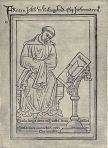That or which: what’s the difference?
Susan Pierotti, Creative Text Solutions
No matter what we write – a report, a blog, a complaint letter - the computer program will intervene to ‘correct’ things, unless you switch it off. One of the inbuilt adjustments to text is a wiggly green line appearing under the word ‘which’.
Do you could ignore it and happily keep typing? Perhaps it annoys you so much that you try to fiddle with the text in the hope of eliminating it. Then again, you may be curious to know why it flashes up on the screen. Read on.
Phrases and commas
Words may be spoken or read. Yet until the invention of the printing press in the western hemisphere made books cheaper and accessible, few people could read. Nearly everyone got information by hearing it. However, a mere 40 years or so after the printing press invention, Europeans were rediscovering the new rich worlds of the Americas, India and China, resulting in an unprecedented increase in wealth.
 The newly emergent middle class was now rich and literate (you had to be if you were in trade). As a result of the Reformation, which also took place at this time, these people wanted and were able to read information for themselves, instead of being read to by someone else. They discovered that to retain information by hearing (using the ears) is quite different from reading (using the eyes). Little marks in the text were carried over from manuscript writing, to help the eye absorb all that text. These were the forerunners of our punctuation marks. They are there as an optical aid.
Commas are especially useful: they break up long slabs of text into bite- (or byte-) sized chunks. One of their functions is to show where a phrase is. Phrases are groups of words that give extra information.
For instance:
The professional proofreading service, which will check the text for errors, will edit your website.
In this sentence you find out not only that the proofreading service will edit your website, but how it will be done. The bit inside the commas is a phrase that gives you the added info. If you omit the commas, the text will be assaulted by the dreaded wiggly green line as it needs the commas to make sense and assist the flow of the sentence.
That which
Let us now change the sentence a little.
The professional proofreading service, which will edit online, will be the best one to hire.
Take out the bit between the commas:
The professional proofreading service will be the best one to hire.Â
The newly emergent middle class was now rich and literate (you had to be if you were in trade). As a result of the Reformation, which also took place at this time, these people wanted and were able to read information for themselves, instead of being read to by someone else. They discovered that to retain information by hearing (using the ears) is quite different from reading (using the eyes). Little marks in the text were carried over from manuscript writing, to help the eye absorb all that text. These were the forerunners of our punctuation marks. They are there as an optical aid.
Commas are especially useful: they break up long slabs of text into bite- (or byte-) sized chunks. One of their functions is to show where a phrase is. Phrases are groups of words that give extra information.
For instance:
The professional proofreading service, which will check the text for errors, will edit your website.
In this sentence you find out not only that the proofreading service will edit your website, but how it will be done. The bit inside the commas is a phrase that gives you the added info. If you omit the commas, the text will be assaulted by the dreaded wiggly green line as it needs the commas to make sense and assist the flow of the sentence.
That which
Let us now change the sentence a little.
The professional proofreading service, which will edit online, will be the best one to hire.
Take out the bit between the commas:
The professional proofreading service will be the best one to hire. ![]() The sentence makes sense grammatically but it doesn’t give you any useful information. Which one is the best to hire? How will you know? This is where the word ‘that’ replaces ‘which’ – and leave out the commas!:
The professional proofreading service that will edit online will be the best one to hire.
Use ‘which’ when the phrase gives added information; use ’that’ when the phrase conveys essential info.
However, if you are still unsure, the services of a professional proofreading and copyediting service will assist you with accurate and comprehensible grammar. Contact www.creativetext.com.au for further assistance.
The sentence makes sense grammatically but it doesn’t give you any useful information. Which one is the best to hire? How will you know? This is where the word ‘that’ replaces ‘which’ – and leave out the commas!:
The professional proofreading service that will edit online will be the best one to hire.
Use ‘which’ when the phrase gives added information; use ’that’ when the phrase conveys essential info.
However, if you are still unsure, the services of a professional proofreading and copyediting service will assist you with accurate and comprehensible grammar. Contact www.creativetext.com.au for further assistance.


